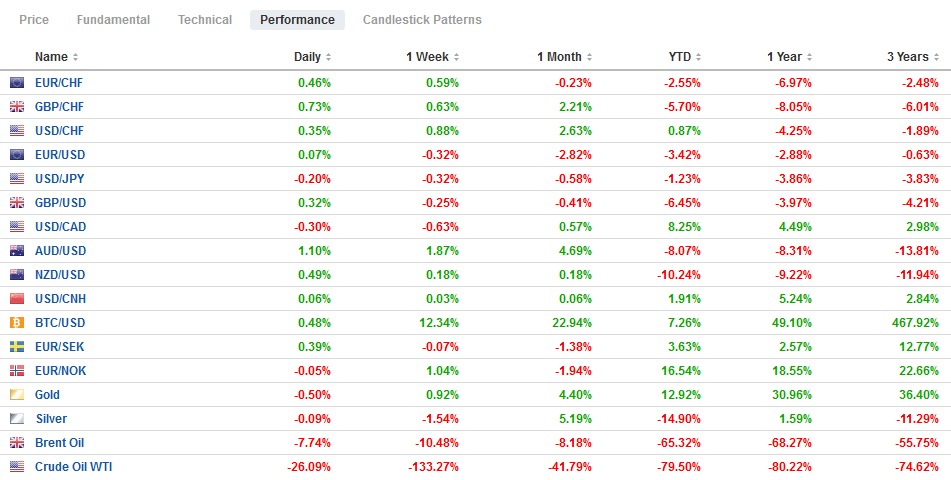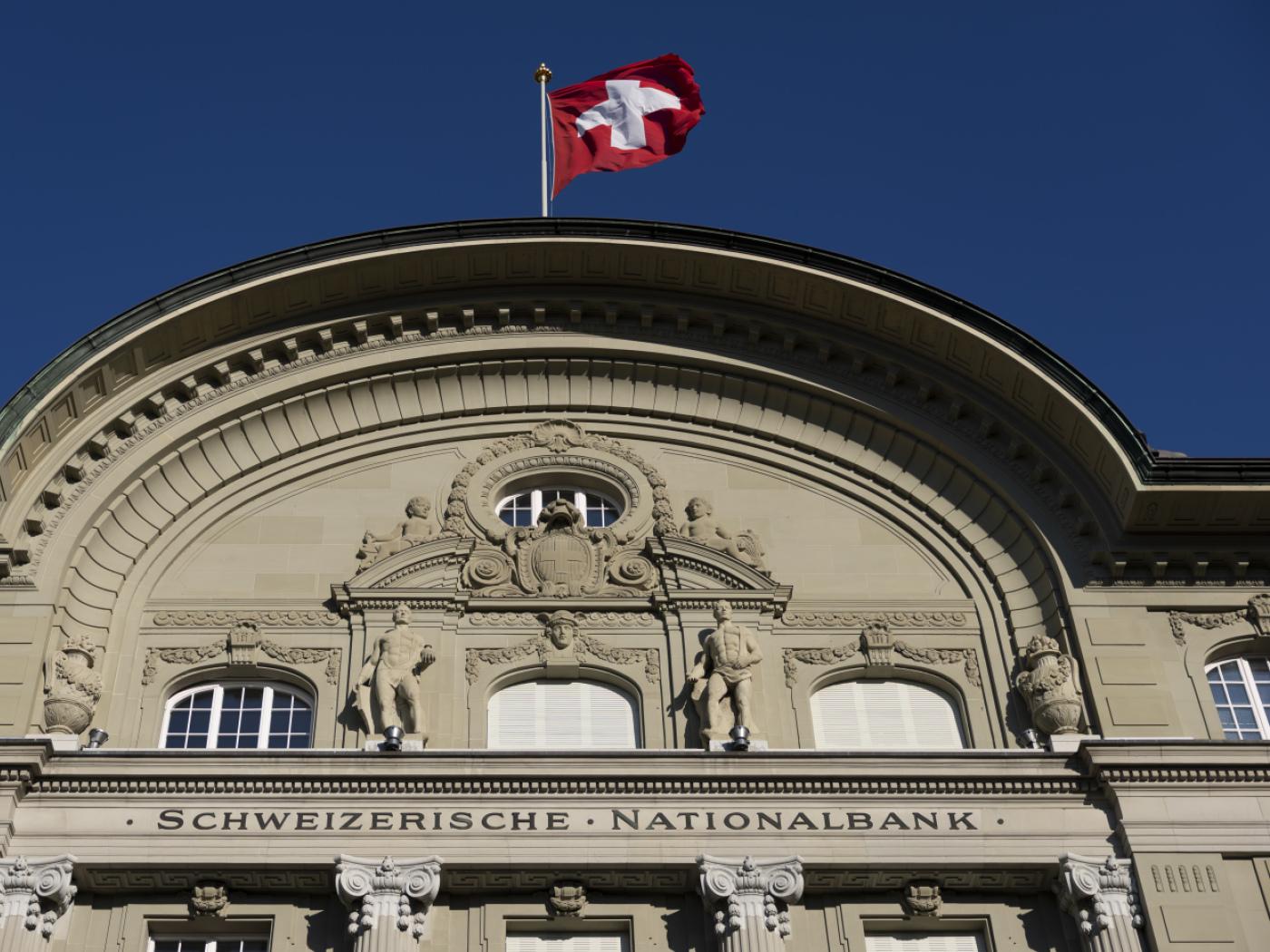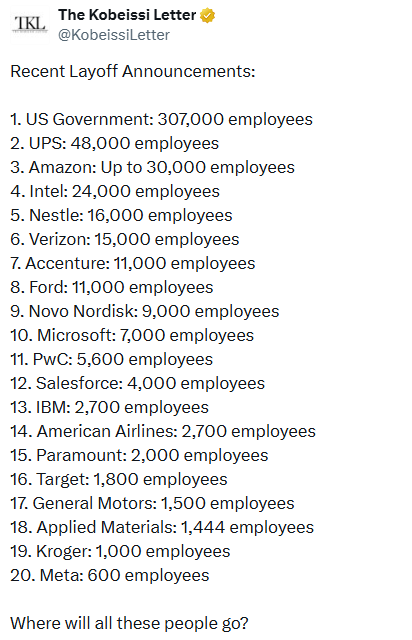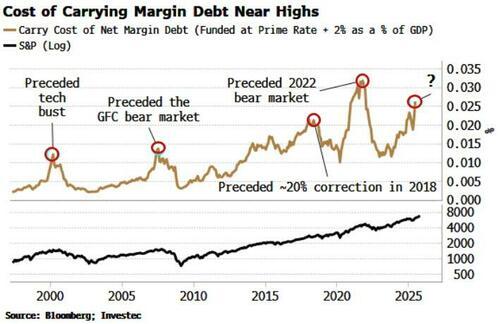Swiss FrancThe Euro has risen by 0.42% to 1.0572 |
EUR/CHF and USD/CHF, April 27(see more posts on EUR/CHF, USD/CHF, ) Source: markets.ft.com - Click to enlarge |
FX RatesOverview: Global equities are beginning the new week on an upbeat note. All the markets in the Asia Pacific region rallied, led by more than 2% gains in the Nikkei and Taiwan. European bourses are higher. All the industry groups are participating and financials and consumer discretionary leading the way. The Dow Jones Stoxx 600 has been in a 320-340 range for the better part of three weeks and is approaching the upper end. The S&P 500 looks poised to gap higher at the opening. The April high just below 2880 is coming into view. Core benchmark yields are a little higher, but the peripheral European bonds are rallying with risk assets. Yields in Italy, Spain, and Portugal are 5-10 bp lower, while Greece’s benchmark yield is off 12 bp. The dollar is softer against all the major and most emerging market currencies. The dollar bloc is the strongest, while the euro and Swiss franc are laggards. JP Morgan’s Emerging Market Currency Index is snapping a five-day slide. Gold is off almost 0.5% as it consolidates above $1700. Crude oil is snapping a three-day advance, and the June WTI contract is near $14 a barrel. |
FX Performance, April 27 |
Asia Pacific
The Bank of Japan made modest adjustments to its policy earlier today. Three steps were taken. First, it removed the JPY80 trillion cap on government bond purchases. This is largely symbolic as the yield curve control policy has seen its bond purchases fall well shy of the cap (~JPY14 trillion over the past 12 months). It did make a minor tweak to the different buckets (maturities) that it will buy. Second, it doubled the amount of corporate bonds, and commercial paper it will purchase (to JPY20 trillion). This was as expected. Third, it expanded access to its emergency loan facility to a wider range of banks. Its forecasts were sobering. Growth, it suggested, could contract by up to 5% (IMF -5.2%), and inflation could be -0.7% this fiscal year.
India’s central bank opened a new credit facility for mutual funds after Franklin Templeton shut six funds last week, citing a lack of liquidity. The new facility is for INR500 bln (~$6.6 bln) as of today that can be lent to the mutual fund industry or buy investment-grade debt held by the funds. Corporate borrowing costs soared after the funds were closed.
The dollar slipped toward the lower end of its two-week trading range against the yen (~JPY106.90-JPY108.10). There is an option for $1.2 bln struck at JPY107.00 that expires today. There are also options for $1.1 bln placed in the JPY107.55-JPY107.60 range that also expire today. The options may mark the range in the North American morning. The Australian dollar was bid to new highs for the month today near $0.6470. Note that $0.6450 corresponded to the (61.8%) retracement of this year’s decline. The next immediate target is near $0.6500, though a close below $0.6445 would be seen as a failure. The Chinese yuan was sidelined and little changed with the dollar near CNY7.08030.
Europe
S&P maintained its BBB rating of Italy and its negative outlook. It noted the ECB’s backstop, and that in nominal terms, assuming no further deterioration in borrowing costs, Italy may pay less to service its sovereign debt the next few years than it did in 2019. It seemed to suggest that it needed so see improvement in the debt trajectory over the medium-term (three years). It suggested the same thing about the UK’s debt trajectory as the rating agency maintained its AA rating. S&P cut the outlook of Greece’s BB- rating to negative.
The Swiss National Bank appears to have stepped up its intervention. Sight deposits jumped by CHF13.4 bln (~$14 bln) in the week ending April 24. They can be influenced by other activities but are believed to reflect ongoing attempts to limit additional strength against the euro. The euro had been hovering just above CHF1.05 over the last couple of weeks, which is its lowest level in about five years. Today, the euro traded near CHF1.0560, its highest in a couple of weeks. A move above CHF1.06 is needed to signal anything important from a technical perspective.
The euro had fallen to its lowest level in a month (~$1.0725) at the end of last week before recovering to settle on the session highs, almost a cent higher. Follow-through buying today lifted it to about $1.0860 in late Asian turnover. It has consolidated in the European morning. The $1.0800-$1.0820 area holds expiring options worth about 1.7 bln euros. Last week’s high was near $1.09, and this needs to be convincingly taken out to lift the tone. Sterling reached a five-day high today near $1.2455. Last week’s top was just above $1.2500. A gain above there is needed to undermine a potential head and shoulders topping pattern some see. Initial support is seen near $1.2420.
America
The busy week in North America begins slowly. The US and Canada have a light schedule today, with Mexico reporting March unemployment statistics. The first look at US Q1 GDP and the FOMC meeting are the highlights. Canada reports February monthly GDP later this week. Mexico also reports Q1 GDP, which is expected to have fallen for the fifth consecutive quarter. US oil inventory data will draw attention. Despite cuts in output, and the shuttering of more oil rigs (-60 last week, leaving 378, a four-year low), US storage space is quickly becoming exhausted, and there is concern that the problem will persist through the expiration of the June WTI contract.
Over the weekend, Treasury Secretary Mnuuchin reiterated that the US was looking at how to help the oil sector. It is not clear if it would be another facility that Fed supported or whether it would be the Treasury or Energy Department taking a leading role. Last week, President Trump again threatened tariffs on oil imports. Trump has also spoken about boosting the Strategic Petroleum Reserves and giving some private producers access to some of its storage capacity. Several of the largest oil companies, including Exxon, Mobil, British Petroleum, and Royal Dutch report earnings this week. Many still insist the lower oil prices are a function of a dispute between Saudi Arabia and Russia. Yet, since 2008, the US has doubled its output, which reached 13 mln barrels per day by the end of last year.
The US is not the low-cost producer, though access to cheap capital helped. The industry was set for consolidation even before the latest drop. Failures and acquisitions are rationalizing the fragmented shale industry and the larger players finding opportunities. Diamond Offshore Drilling became the latest casualty over, filing bankruptcy after missing a debt servicing payment a week and a half ago. Last year, its losses doubled to almost $360 mln as revenues fell by about $100 mln to $980 mln. We suspect that most of the US assistance would not go to the small fledgling producers, many of whom are not investment grade. If this is true, it may accelerate the re-shaping of the industry, while at the same time, putting down a marker that claims the US will not bear the burden of the global adjustment: Saudi Arabia and Russia need to accommodate it.
The Brazilian real slumped to record lows before the weekend following the resignation of the Justice Minister Moro, who was held in high regard as the driving force behind the anti-corruption Car Wash investigation that ultimately jailed former President Lula. It followed the dismissal of the head of the Federal Police. President Bolsonaro has been widely criticized for the handling of the health crisis and last week dismissed the Health Minister that favored social isolation. The Bovespa lost roughly 5.5% at the end of last week.
The US dollar traded between CAD1.40 and CAD1.42 last Thursday. This range is still key for the near-term outlook. After finishing last week near CAD1.4100, the US dollar slipped to about CAD1.4040 before finding support. We continue to see the Canadian dollar more sensitive to the risk appetite (S&P 500 proxy) than oil prices per se. A convincing break of the CAD1.40 area would target the month’s low near CAD1.3860. The greenback closed firmly against the Mexican peso at the end of last week after poking above MXN25.00 for the first time since April 6, when the record high was set (~MXN25.7850). It is trading within the pre-weekend range and found support near MXN24.75, just above the five-day moving average.
Full story here Are you the author? Previous post See more for Next post
Tags: #USD,Brazil,Currency Movement,EUR/CHF,India,newsletter,OIL,USD/CHF






























